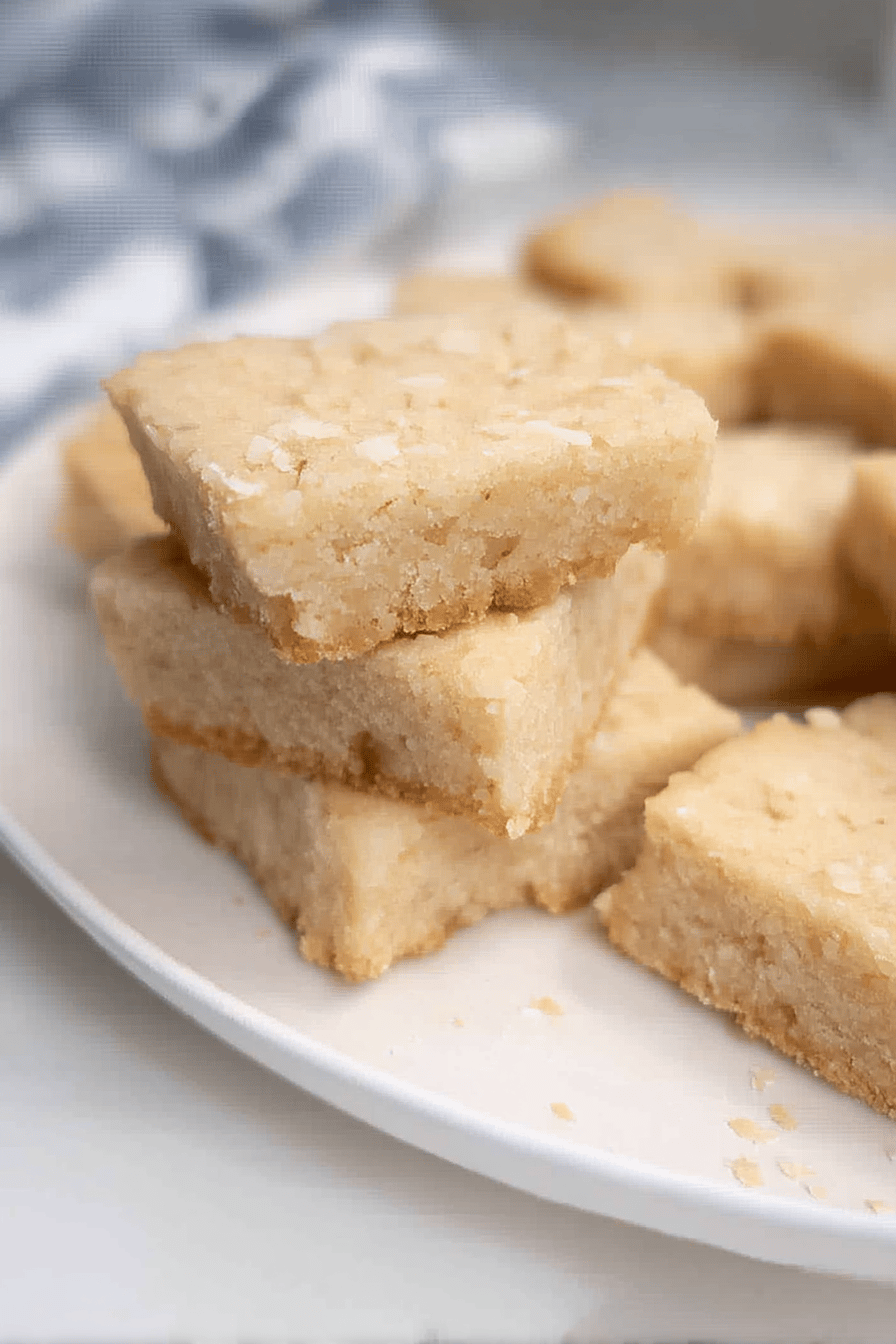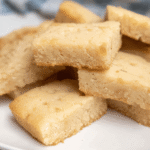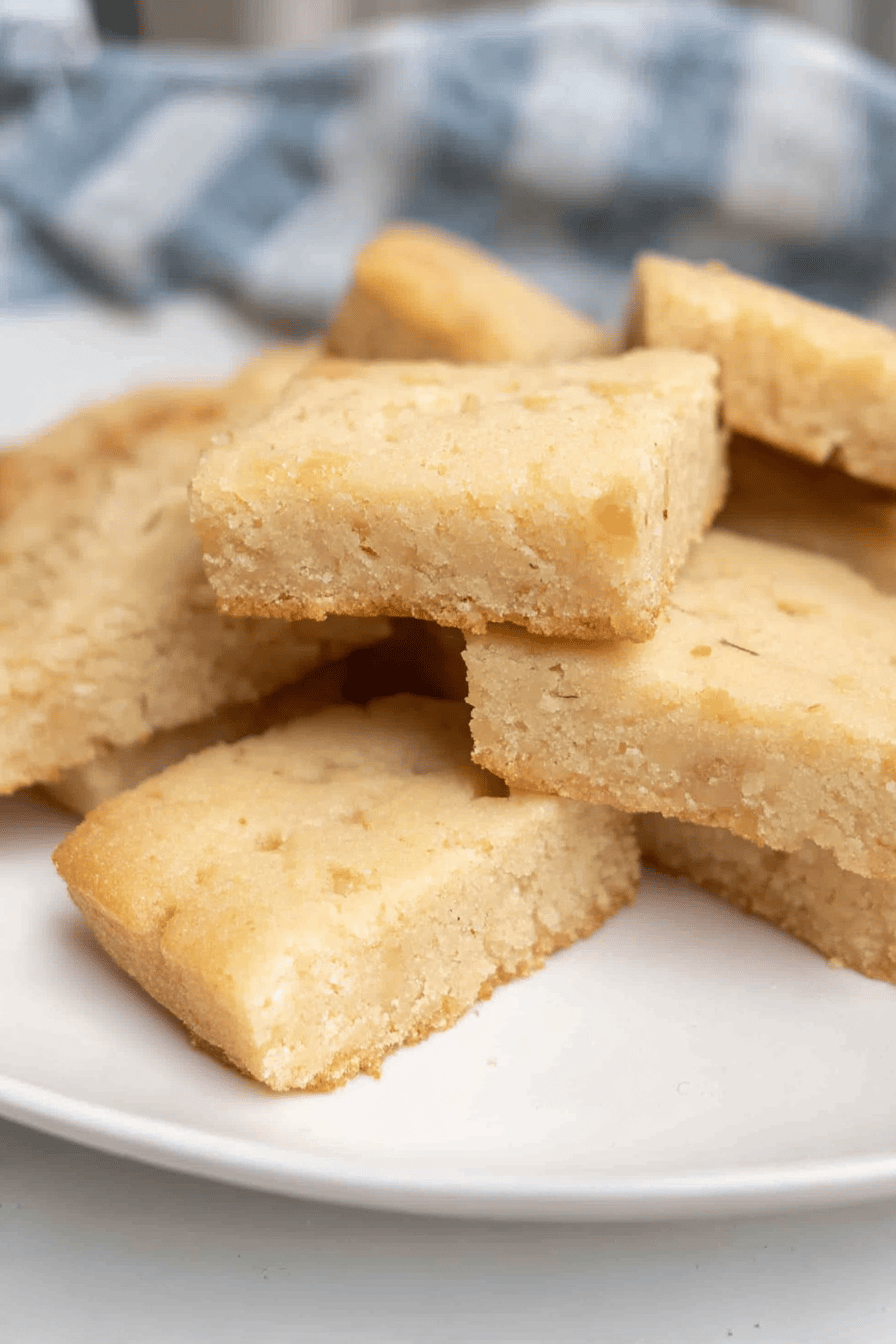Why You’ll Love This traditional scottish shortbread
- Ease of preparation: This traditional Scottish shortbread recipe is wonderfully simple, requiring just three main ingredients and straightforward steps. With minimal prep and a quick baking time of around 25-35 minutes, it’s perfect for both novice and experienced bakers seeking a classic buttery treat without complicated techniques.
- Health benefits: Made with wholesome ingredients like high-quality butter and flour, traditional Scottish shortbread provides essential fats and carbohydrates for energy without additives or preservatives. Controlled portions offer a moderate calorie intake, making it an enjoyable indulgence within a balanced diet.
- Versatility: The recipe is highly adaptable for various dietary needs. Whether you’re looking for gluten-free by using alternative flours, vegan by substituting butter with plant-based options, or low-calorie by reducing sugar or butter amounts, this classic shortbread can meet diverse preferences while preserving its signature texture.
- Distinctive flavor: Known for its rich, buttery taste and delightfully crumbly texture, traditional Scottish shortbread carries an unmistakable flavor linked to authentic baking methods. The delicate balance of sweetness, tender crumb, and melt-in-your-mouth quality stands out as a timeless favorite adored worldwide.
Jump To
- 1. Why You’ll Love This traditional scottish shortbread
- 2. Essential Ingredients for traditional scottish shortbread
- 3. How to Prepare the Perfect traditional scottish shortbread: Step-by-Step Guide
- 4. Dietary Substitutions to Customize Your traditional scottish shortbread
- 5. Mastering traditional scottish shortbread: Advanced Tips and Variations
- 6. How to Store traditional scottish shortbread: Best Practices
- 7. FAQs: Frequently Asked Questions About traditional scottish shortbread
- 8. traditional scottish shortbread
Essential Ingredients for traditional scottish shortbread
- 225 grams (1 cup) salted butter, softened (not melted) – provides richness and the characteristic crumbly texture
- 100 grams (½ cup) granulated or caster sugar (superfine preferred) – adds sweetness and tenderizes the shortbread
- 240 grams (2 cups) all-purpose flour – forms the structure and base of the dough
- ¼ teaspoon table salt (optional) – enhances flavor, especially when using unsalted butter
Special Dietary Options
- Vegan: Use plant-based butter substitutes such as vegan margarine or coconut oil for a plant-friendly alternative.
- Gluten-free: Replace all-purpose flour with a gluten-free flour blend compatible with baking shortbread.
- Low-calorie: Opt for light butter alternatives and reduce sugar quantity or use sugar substitutes suitable for baking to lower calorie content.
How to Prepare the Perfect traditional scottish shortbread: Step-by-Step Guide
First Step: Preheat and Prepare
Preheat your oven to 160°C (320°F). Line an 8-inch square baking pan with parchment paper, leaving some overhang for easy removal of the baked shortbread later. This preparation ensures even baking and effortless cleanup.
Second Step: Cream Butter and Sugar
In a large mixing bowl, beat the softened butter and granulated sugar together until just combined, avoiding over-creaming. For vegan or low-calorie options, use your chosen butter substitute. The goal is to create a mixture that is smooth yet not overly aerated to maintain the tender crumb.
Third Step: Incorporate Flour and Salt
Sift the all-purpose flour and table salt (if using) into the butter mixture. Gently mix using a spatula or hands until the dough just comes together with a crumbly texture. Avoid overworking the dough to prevent toughness and maintain the characteristic shortbread crispness.
Fourth Step: Shape and Dock the Dough
Press the dough evenly and firmly into the prepared pan to ensure uniform thickness, approximately ½-inch thick. Use a fork to prick the surface at about 1-inch intervals to allow steam to escape and prevent sogginess during baking. Optionally, sprinkle a little extra sugar on top for a lightly sweet crust.
Fifth Step: Chill Before Baking
Chill the dough in the refrigerator for 30 minutes to 2 hours to solidify the butter, which helps maintain shape and enhances flakiness during baking. This chilling also keeps the pricked holes clear for steam escape.
Sixth Step: Bake to Perfection
Bake the shortbread in the preheated oven for 25 to 35 minutes, watching carefully for edges to become light golden while the center remains pale. Baking time may vary depending on oven type and pan material, so rely on visual cues rather than time alone.
Seventh Step: Cool and Cut
Remove the shortbread from the oven and let it cool in the pan for about an hour to firm up. Then, use the parchment overhang to lift it out and cut into traditional bars or wedges while still slightly warm for clean slicing.
Final Step: Serve and Store
Enjoy your traditional Scottish shortbread with a cup of tea like Earl Grey. Store in an airtight container at room temperature for 5-7 days to maintain its buttery freshness or freeze for up to 3 months for longer preservation.
Dietary Substitutions to Customize Your traditional scottish shortbread
Protein and Main Component Alternatives
- Use vegan butter or coconut oil as a plant-based fat substitute to create vegan traditional Scottish shortbread.
- Replace all-purpose flour with gluten-free baking blends such as rice flour or almond flour mixes suitable for cookies.
Vegetable, Sauce, and Seasoning Modifications
- Add flavor twists by incorporating ingredients like vanilla extract, lemon zest, or almond extract sparingly for subtle aroma.
- Experiment with coating or dusting the shortbread with lavender, rosemary, or finely ground nuts to vary texture and taste.
- Use herb-infused salts or replace regular salt with sea salt flakes for a different seasoning experience.
- Replace granulated sugar with natural sweeteners like honey or maple syrup but adjust the dough consistency accordingly to maintain texture.
Mastering traditional scottish shortbread: Advanced Tips and Variations
Chilling the dough is essential to prevent spreading and help maintain a tender crumb that melts in your mouth. Avoid rushing this step for best results.
- Pro cooking techniques: Use high-fat European-style butter if possible; its quality greatly influences flavor and texture. Cut butter into small cubes and keep it cold before mixing to avoid greasy dough.
- Flavor variations: Try adding subtle notes like vanilla bean seeds, lemon or orange zest, or carefully balanced herbs such as rosemary or lavender for unique yet classic twists.
- Presentation tips: Dust finished shortbread with powdered sugar or drizzle with melted dark chocolate for a sophisticated touch, ideal for gifting or special occasions.
- Make-ahead options: Prepare the dough in advance and either bake on demand or freeze the raw dough in portions, thawing before baking to save time on busy days.
How to Store traditional scottish shortbread: Best Practices
| Storage Method | Guidelines |
|---|---|
| Refrigeration | Store shortbread flat in an airtight container at room temperature or in the fridge for up to one week. This prevents it from going stale or absorbing unwanted odors. |
| Freezing | Freeze baked or raw shortbread tightly wrapped in freezer-safe bags for up to three months. Thaw at room temperature before serving. |
| Reheating | Warm shortbread gently in a low oven (around 300°F/150°C) for a few minutes to refresh crispness and softness without drying out. |
| Meal prep considerations | Batch bake and store shortbread in portions for quick access. This reduces spoilage and maintains optimal crumbly texture throughout the week. |

FAQs: Frequently Asked Questions About traditional scottish shortbread
Why are there holes in traditional Scottish shortbread?
The holes, called docking, allow steam to escape during baking. This prevents the shortbread from becoming soggy and helps maintain its signature crumbly, melt-in-the-mouth texture. Although the holes may become less visible if the butter is warm, they still serve their purpose in ensuring even baking.
What makes Scottish shortbread different from other shortbread recipes?
Traditional Scottish shortbread contains only three main ingredients: butter, sugar, and flour, without leavening agents or additional flavorings. It is thicker and has a crumbly, tender texture. Some other recipes add cornstarch, baking powder, or vanilla, which change the texture and flavor from the classic Scottish style.
How can I tell when Scottish shortbread is baked perfectly?
Scottish shortbread should remain pale with edges turning just lightly golden. Baking at a low temperature helps cook it through without over-browning. When the edges show the first sign of light golden color, it’s a good indication to remove it from the oven for a tender but crisp finish.
Can I use unsalted butter when making Scottish shortbread?
Yes, unsalted butter works well and allows control over salt levels. If using unsalted butter, add about ¼ teaspoon of salt to balance flavor. High-quality real butter is important for authentic taste and texture.
What is the best way to store Scottish shortbread to keep it fresh?
Store shortbread in an airtight container at room temperature. Properly stored, it can stay fresh and crumbly for up to four weeks. Avoid refrigeration as it can affect texture and cause the biscuits to dry out.

traditional scottish shortbread
- Total Time: 30-150 minutes
- Yield: About 16 servings
- Diet: Vegetarian
Description
🥮 Savor the rich, buttery crumbly texture of Traditional Scottish Shortbread, a timeless treat made with simple, quality ingredients.
🥩🍤 Complements savory dishes like steak and shrimp stir fry, offering a delightful contrast for a balanced meal experience.
Ingredients
– 225 grams salted butter
– 100 grams granulated or caster sugar
– 240 grams all-purpose flour
– ¼ teaspoon table salt
Instructions
First Step: Preheat and Prepare Preheat your oven to 160°C (320°F). Line an 8-inch square baking pan with parchment paper, leaving some overhang for easy removal of the baked shortbread later. This preparation ensures even baking and effortless cleanup.
Second Step: Cream Butter and Sugar In a large mixing bowl, beat the softened butter and granulated sugar together until just combined, avoiding over-creaming. For vegan or low-calorie options, use your chosen butter substitute. The goal is to create a mixture that is smooth yet not overly aerated to maintain the tender crumb.
Third Step: Incorporate Flour and Salt Sift the all-purpose flour and table salt (if using) into the butter mixture. Gently mix using a spatula or hands until the dough just comes together with a crumbly texture. Avoid overworking the dough to prevent toughness and maintain the characteristic shortbread crispness.
Fourth Step: Shape and Dock the Dough Press the dough evenly and firmly into the prepared pan to ensure uniform thickness, approximately ½-inch thick. Use a fork to prick the surface at about 1-inch intervals to allow steam to escape and prevent sogginess during baking. Optionally, sprinkle a little extra sugar on top for a lightly sweet crust.
Fifth Step: Chill Before Baking Chill the dough in the refrigerator for 30 minutes to 2 hours to solidify the butter, which helps maintain shape and enhances flakiness during baking. This chilling also keeps the pricked holes clear for steam escape.
Sixth Step: Bake to Perfection Bake the shortbread in the preheated oven for 25 to 35 minutes, watching carefully for edges to become light golden while the center remains pale. Baking time may vary depending on oven type and pan material, so rely on visual cues rather than time alone.
Seventh Step: Cool and Cut Remove the shortbread from the oven and let it cool in the pan for about an hour to firm up. Then, use the parchment overhang to lift it out and cut into traditional bars or wedges while still slightly warm for clean slicing.
Final Step: Serve and Store Enjoy your traditional Scottish shortbread with a cup of tea like Earl Grey. Store in an airtight container at room temperature for 5-7 days to maintain its buttery freshness or freeze for up to 3 months for longer preservation.
Notes
🧈 Use room temperature butter—not too soft or melted—to achieve the perfect crumbly texture.
🍴 Prick the dough evenly with a fork to allow steam to escape and prevent sogginess during baking.
⏳ Chill the dough before baking to help maintain shape and enhance the shortbread’s delicate texture.
- Prep Time: 5-15 minutes
- Chilling time (optional): 30-120 minutes
- Cook Time: 25-35 minutes
- Category: Dessert
- Method: Baking
- Cuisine: Scottish
Nutrition
- Serving Size: 1 bar or wedge
- Calories: 70
- Sugar: 6 g
- Sodium: 5 mg
- Fat: 4 g
- Saturated Fat: 2.5 g
- Unsaturated Fat: 1 g
- Trans Fat: 0 g
- Carbohydrates: 9 g
- Fiber: 0.2 g
- Protein: 1 g
- Cholesterol: 15 mg
Keywords: Scottish Shortbread, Traditional, Steak, Shrimp



This brings back so many lovely memories of my grandmother baking these for us! ☺️ I tried your version, and it was perfect. Do you think adding a touch of lemon zest would work? Thanks for sharing this gem of a recipe!
★★★★★